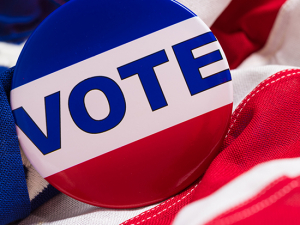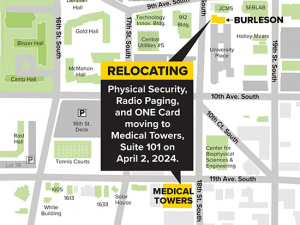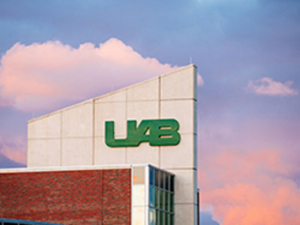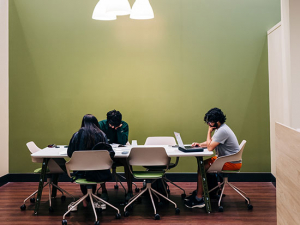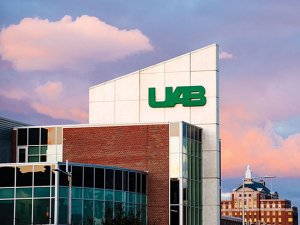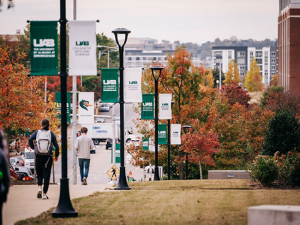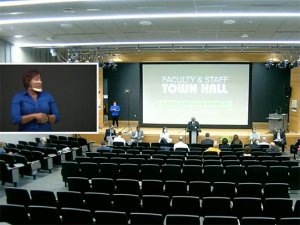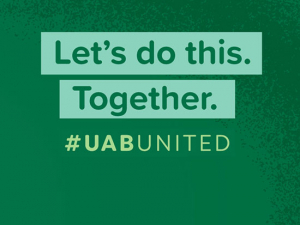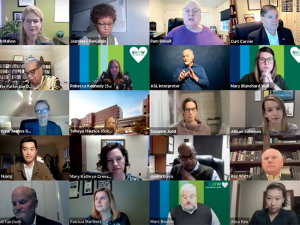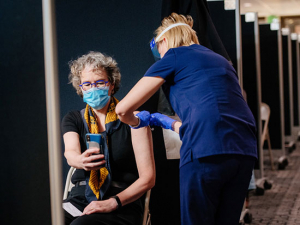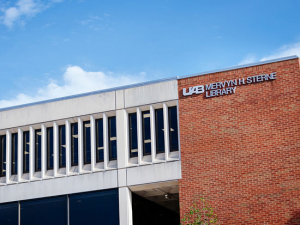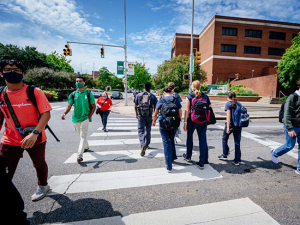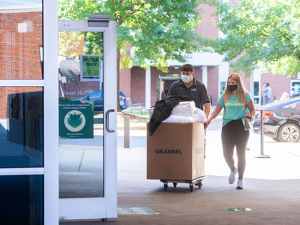Data and reactions from the first three weeks of the fall semester, which began Aug. 24, were the focus of a town hall for employees Sept. 11. President Ray Watts, Provost Pam Benoit and other UAB leaders shared encouraging data on COVID-19 positive tests on campus and answered common questions submitted prior to and during the event.
“I want to say thank you to everyone for your contributions and your hard work; it has helped us to get off to a good start for fall semester,” Watts said.
Scroll down to read the complete summary or use the links below to jump to specific topics
Record research funding, enrollment expected
COVID-19 positive diagnosis rates at UAB
Benefits changes, holidays and 403(b) plan
Re-entry phases and metrics for closure
Record research funding, enrollment expected
UAB’s clinical expertise is back up to full speed, Watts noted, and “the research enterprise is almost at full capacity.” Research funding is on track to set a new record, he said. “We’re expecting to be up over $30 million this year over last year, and last year was our best year so far. Our faculty and staff are adapting well to the changes, the technological glitches have been corrected, and by and large instruction is going on in a meaningful way.”
| This article summarizes comments made and questions answered during the Sept. 11 employee town hall. An upcoming article will provide answers to questions that could not be addressed live due to time constraints. |
Enrollment has increased as well, with a 2% improvement forecast over this past year’s record enrollment of more than 22,000, Watts said.
[back to topic list]
COVID-19 positive diagnosis rates at UAB
In the past week, 1,309 faculty, staff and students were tested as part of UAB’s sentinel testing program, with only one person testing positive. “We’ve had one or two positives in the residence halls, and we have three students residing in the on-campus quarantine space and doing well,” Watts said. “This past week, 27 students were positive, seven academic faculty and staff were positive and 40 [members of the] clinical enterprise were positive, for a total of 74. That is less than 1% of our 40,000-plus employees and students.”
From the beginning of the COVID-19 pandemic in Alabama in March, “we’ve had less than 1% of students test positive and 122 university and academic faculty and staff test positive,” Watts said. “That is very, very low. We’ve had 861 in our clinical enterprise that have been positive. That equates to about 4.8%. For faculty and staff it’s 1%, and for students it’s less than 1%.” Most of the infections that have occurred “were acquired off-campus,” Watts added.
These data demonstrate that “our safety measures are working,” Watts said. “But we cannot let our vigilance and diligence down. We have to be as focused today as we have been in the past months to keep a strong semester.”
[back to topic list]
First three weeks in review
“In my opinion, we got off to a bit of a bumpy start, but now things are evening out,” Benoit said. “I want to thank the faculty, the staff, the students and everyone who helped that happen. The compliance rate for people doing their training and doing Healthcheck on a daily basis has been very good. I appreciate your efforts there.”
Reporting noncompliance
Questions submitted prior to the town hall had asked about how to report noncompliance with mask wearing and social distancing, Benoit said. There are numerous ways to report, she explained.
- Ask your supervisors to address the issue
- Report through the https://www.uab.edu/ethics/file-a-report-online/options">Ethics Hotline
- Students can also report to the OneStop Student Center
Question submitted online:
People are not wearing masks in my building. Is there an easy way to report this?
“Talk to your supervisor initially,” Watts said. “Sometimes having a face-to-face conversation is a way to make sure everyone is on the same page and understands the rules and regulations. If you don’t feel comfortable, you can report that to the Ethics Hotline.”
Katie Crenshaw, J.D., UAB’s chief risk and compliance officer, explained what happens when a report is made through the Ethics Hotline. “The reports can be made anonymously, but the more details that we have, we can better understand the nature and the circumstances and we can do a full review,” Crenshaw said. The Ethics Hotline is a third-party tool that allows individuals to be anonymous, she said. The reports are “received here in the Risk and Compliance office, and we review each and every report that comes forward to understand the facts of the situation and to work with leadership to take appropriate action where there are findings of noncompliance.”
In many of the cases reported so far, “we’re finding that there is not a shared understanding of what the health and safety requirements are and how they need to be implemented in a particular place or unit,” Crenshaw added. “There is an opportunity then for education and realignment of understanding with the people involved.”
Noncompliance also can be reported to building administrators and departmental leadership, Crenshaw said.
“We want you to report noncompliance,” Watts said. “It’s our expectation that everyone — including me and everyone else on campus — complies with the safety measures. They are for your own health and the health of those around you. If someone is not wearing their facemask and is around other employees, they are not being respectful of the employees and not following the guidelines. If there is repeat offending, there are consequences, up to immediate dismissal. If you know someone and can say, ‘Look, your mask slid down’ or ‘You don’t have your mask on,’ and you can comment to them that way and they won’t be offended,” take that opportunity to do so, Watts said. “But if not, go through these mechanisms. We’ll keep it anonymous, and we will definitely act on it.”
‘Not a time for us to change or let up’
“The work that has occurred at UAB by the students, the leadership and the faculty is remarkable and it is a model for the country in many ways,” said Selwyn Vickers, M.D., senior vice president and dean of the School of Medicine. “It is not a time for us to change or let up in the behavior that has given us an early measure of success.”
The pandemic will be here throughout the fall semester, Vickers said. “Follow the guidelines and rules that have been put in place. I can’t emphasize that enough.” It is important also to be mindful that “our community still has areas where we need to improve,” including the overall positivity rate in Jefferson County, Vickers said.
Echoing Watts’s comments, Vickers noted that positive diagnoses for students, faculty and employees, including on the health side, have been largely the result of community spread rather than on-campus or in-hospital spread of COVID-19. “When we are around friends and family it is easy to think, ‘They would never carry COVID-19,’ but they are,” Vickers said. “We need to be careful.”
[back to topic list]
Employee Health
Healthcheck
“If you have symptoms or exposures, Healthcheck is the place to report those,” said Sarah Nafziger, M.D., medical director for UAB Employee Health. “Everyone is doing a great job filling out the Healthcheck.”
There have been reports of some “confusion around the Healthcheck and the Exposure Notification App and what it means if you get an exposure notification,” Benoit said. A set of PowerPoint slides is being developed that faculty can use in their classes to clear up confusion, she said. “We anticipate those will be out next week.”
Questions submitted online:
Will I have to complete the daily Healthcheck while on maternity leave?
“If you are on maternity leave or [another] approved leave and your department marks that you are not onsite working, then you won’t show up in the noncompliance listing,” said Alesia Jones, chief human resources officer for UAB.
Why do we have to complete the Healthcheck daily if we are in a situation where we are only coming to campus one day a week?
“We originally started with an every-three-days [requirement] because we felt that was sufficient,” Watts said. “We moved to a daily Healthcheck so that we have a finger on the pulse of how many employees are sick and who may need additional medical care, quarantining, etc. And it’s easier to do daily. It’s like brushing your teeth in the morning before you leave for work…. And you can do your Healthcheck in under a minute. I time myself putting in my ID and password. If I don’t flub it up, I can do it in 59 seconds.
“We need to know if there are any increases in symptoms and then we go through the protocols that have been established by the medical and public health professionals,” Watts said. “If you are coming one day a week, we want to know that you are healthy…. That is in part why we’ve been able to have a healthier UAB community than most universities — certainly more than most universities with a large academic medical center — around the country.”
[back to topic list]
UA System dashboard
Weekly updates on the number of positive diagnoses among staff, faculty and students at UAB, the University of Alabama in Tuscaloosa and the University of Alabama in Huntsville are being reported on the University of Alabama System dashboard, Nafziger said.
[back to topic list]
Work restrictions
Employee Health has received many questions about work restrictions following a COVID-19 diagnosis or exposure, Nafziger said — and the requirements “can be confusing and complicated,” she acknowledged.
Work restrictions after a positive diagnosis: “If you are positive, you have to be work-restricted for a minimum of 10 days,” she said. Work restrictions may be longer than 10 days depending on the time needed to recover and be free of symptoms, Nafziger said. But all employees must wait at least 10 days.
Work restrictions after a close-contact exposure: “This is the point where the rules are different” between university and hospital employees, Nafziger said.
A close contact is “when you are around someone COVID-positive, less than six feet away from them for more than 15 minutes” over the course of 24 hours, Nafziger said. “You could have three five-minute exposures, but it counts as 15 minutes cumulatively.”
Work restrictions for clinical workers after a close-contact exposure: If you are a clinical worker, the work restrictions do not apply, Nafziger noted. This is because of the PPE use in clinical settings, she said.
Work restrictions for university employees after a close-contact exposure: If you are a university employee with a close contact, “you have a 14-day restriction on coming to campus,” Nafziger said. “I know that’s a hard pill to swallow for a lot of people. We’ve had a lot of employees calling us and working through the stages of grief of receiving a 14-day order. But it’s what we need to do to keep the campus safe.”
Work restrictions while waiting for test results:
Someone with symptoms who has been tested is on work restriction and cannot come to campus “until we know whether or not you have COVID-19,” Nafizger said. Someone being tested as part of sentinel testing or entry testing (for employees returning to campus) who does not have symptoms will not face any work restrictions until the test results are returned.
[back to topic list]
Flu shots
“This year it is vitally important for you to receive a flu vaccination,” Nafziger said. “With COVID-19 on the rise, the last thing we want is a big flu outbreak. When we have widespread flu transmission it adversely affects our ability to provide medical care and puts a strain on the system.”
Another issue, Nafziger said, is that “it’s going to be hard to sort out if you have flu or COVID-19.”
Campus employees can get flu shots by appointment on Tuesdays and Thursdays beginning Sept. 22 through Occupational Health and Safety. UAB Medicine employees will begin receiving flu shots on Oct. 1.
Those working remotely who are not able to come in for these on-campus shots should know that “flu shots are covered at no cost in all of our medical plans, and they are provided at local pharmacies and retailers,” said Alesia Jones, chief human resources officer for UAB.
[back to topic list]
Human Resources
Payroll tax deferral
An executive order issued Aug. 8 provides employers the option to suspend collection of payroll taxes for eligible employees Sept. 3-Dec. 31, 2020, on the condition that deferred taxes be repaid Jan. 1-April 30, 2021. However, “UAB [and the other University of Alabama System campuses] will continue to withhold payroll taxes,” Jones said, pointing those wanting more information to this UAB Reporter article.
[back to topic list]
Benefits changes, holidays and 403(b) plan
“We’re nearing completion of work to update you” on each of these matters, Jones said. “We’re really close... we’ll give you that information as soon as it is available.” The 403(b) retirement plan is shared across all UA System campuses, Jones noted, with decisions made at the system level. “Look to your eReporter for plan changes and updates.”
[back to topic list]
Telecommuting agreement
Employees working remotely recently received emails asking them to sign an updated Temporary Telecommuting Agreement, with an end date no later than Dec. 31. “That doesn’t mean that everything is going to return to normal in January and that you will be expected to return to the office like we were prior to COVID-19,” Jones said. “It’s still uncertain as to how 2021 will look and what will be required then. But it was a temporary agreement that needed a timeframe around it.” New information will be provided “as we get closer to the new calendar year,” Jones said.
[back to topic list]
Look to eReporter for latest
“For all of the things that we’re working on... continue to look to the eReporter,” Jones said. “As soon as information is available, you’ll be able to find it there.”
[back to topic list]
Childcare resources
Emily Wykle, project director in the Office of the President, provided an update on “how we are supporting working parents at this time,” she said.
Two UAB-sponsored programs are fully operational:
- a partnership with the McWane Center for children in grades K-6 whose schools are not open. “They can do their virtual learning assignments there,” Wykle said.
- the Virtual Learning Hub at the Hilton at UAB. “We’ve hired and trained UAB students who are running a program there for children in small groups — no more than six children — and they will be participating in tutoring and receiving general support to complete their online learning,” Wykle said. This option is designed to be a part-time service for employees who need to come to campus periodically, such as to teach a class or spend time in a lab, Wykle said. “You just need to reserve the time that you would like to be there and there is a small, nominal fee. You can leave your children there and know they are in a safe and secure environment, and it is cheaper than a babysitter.”
The Childcare Resources page on the Human Resources website includes an updated list of day care centers in the area with openings, Wykle added. “We have a survey going out to learn more about current obstacles and needs as we move through the fall semester,” she said.
[back to topic list]
Parking and transportation
The following questions were submitted online:
As an essential research worker and someone with Remote 3 parking, is there a way to help us with closer temporary parking?
Can staff that have returned to campus have temporary passes to decks? We’re having to wait long times for buses that are often full.
“We did allow people to park in lots and decks that they were not normally assigned to,” said André Davis, director of Transportation at UAB. “With school starting in August, we needed to return to a pre-COVID-19 condition to give us time to assess what the availability would be when school started. We’ve been closely recording the numbers of cars in decks and we met this week to roll out a month-to-month plan to help with that. We understand that there are spaces available now. But we didn’t want to risk assigning those to other people and then those assigned to them previously could not find a place to park. We’re looking at that [now] and we’ll work with the UAB communications team to get that information out to all employees.”
Will there be any adjustments made to Blazer Express routes?
“We’ve suspended the Gold Route, the Green Route and the Purple Route, and we’re looking at other services that need to be temporarily suspended because of lack of usage and where we need to place the equipment in other locations,” Davis said.
“We are complying with the CDC guidelines for the buses. It is hard to get six feet apart on the bus, but for the buses [the CDC guideline] really is 50% capacity. We’re strictly enforcing the face-covering requirement with drivers and passengers. And we’ve recently installed a state-of-the-art disinfectant process on the buses. We’re the first campus in the state to do that and we are the first to have the technology on our campus. We’re doing that so we can provide the safest environment for our people.”
Learn more about the sanitation process and watch a video of it in action in this UAB News story.
[back to topic list]
Re-entry phases and metrics for closure
Several employees submitted questions asking which phase of entry the university is in currently.
“We’re still working in a modified business operations model right now,” said Katie Crenshaw, J.D., UAB’s chief risk and compliance officer, who also is chair of the university’s Incident Command Committee. (The latest re-entry status can always be found on the UAB United website, Crenshaw added.)
Approximately 70% of faculty and staff are back on campus full-time or in a hybrid capacity, Crenshaw said. “We’re seeing an increase in traffic and interactions on campus.”
What metrics are being used to determine phases of return?
There is no single metric “that we could use to determine what phase we are in and at what point we would move to green or backward to orange,” Crenshaw said. “Adhere to the health and safety standards to continue the success that we have had so far and keep an eye on the UAB United website for additional information.”
“Originally when we put the phases together, we had multiple levels of phase yellow,” Provost Benoit said. “As it evolved, we collapsed that to a single phase. So you may have confusion about that, but we’re sitting in the general yellow phase at the moment.”
Do we know a number of cases in our community that would cause us to move back?
“There is no single measure,” President Watts said. “We’re among the lowest of any campus in America in numbers of cases among our students and faculty and staff. Our health care population is large — there are 17,000 employees – and even though we have had around 800 [positive cases among UAB Medicine employees], considering the number of employees and that this is cumulative from March to now, they are doing extremely well also.”
Still, “no case is acceptable, so we’ll not lower our attention to detail in any way, and we’ll do that throughout this semester and going forward,” Watts said. “We know that the COVID-19 virus will be with us for many months, maybe a year or two. Obviously, the vaccine work is important and we are involved in that. But we have to continue to plan as if the virus is active among us.”
If the University of Alabama in Tuscaloosa numbers continue to go up, causing them to shut down, will UAB have to shut down as well?
“We’ve not had a conversation among the presidents and chancellor,” Watts said. “Each campus will do what is best for them. If we remain where we are, then we want to remain at the current activity levels and keep our students, faculty and staff on campus. The same with UAH. Their numbers have been low. But we’ll stay apprised of that. We stay in contact daily with the Incident Command Center, and we monitor the numbers several times a day.”
[back to topic list]
Other questions
Is there any discussion yet if UAB employees will be required to take a vaccine once one is available?
“We haven’t had that formal discussion, but I think that if there is a vaccine, or multiple vaccines, that are safe and shown to be so through controlled, Phase III clinical trials and meet all acceptable criteria, we would very, very strongly suggest that everyone have a vaccine,” Watts said. “But we’re not there yet. We don’t have an effective vaccine yet.”
“The flu vaccine is required on the UAB Medicine side — it’s a core principle for working with patients,” Vickers said. “We want to make sure that we prevent spread to other individuals that we work and care for.” He anticipates that “a similar attitude would be toward the COVID-19 vaccine once [it has] been proven to be safe and effective. That’s a principle that we would look for on the health care side, and it would be very much desired on all of our campuses.”
There is a group that has met to discuss the distribution of a COVID-19 vaccine when and if that is available, Nafziger said. “We’ve formatted plans on how it would be distributed, similar to flu vaccinations. There is a group developing a process and operational platform to make sure we can deliver it when it is available. That is being considered, and there is already a plan in writing.”
What is UAB doing about the erroneous New York Times article?
“The Public Relations team has been working with local, national and state media outlets and we’ve received [more] positive news coverage for our institution and experts than we ever have,” said Jim Bakken, associate vice president for Strategic Communications and chief communications officer for UAB. “We were disappointed to see the report that was wrongly reported in the Times. [For more details, see this story from UAB News.] They combined the university numbers and the clinical side and they listed us as the number-one hot spot for COVID-19 [in the country]. When that came out, we phoned multiple contacts at the New York Times and initially did not get traction. We elevated our concerns up the chain of command and we got involved with a lot of editors and about a week ago, on Thursday morning a week ago, we were able to get traction and they made adjustments. They removed it from a ranking display and used more of an alphabetical listing, [but] we still have several issues that we take with the display of information. And continuing this week, we’re talking to the national editor and standards editor to encourage additional edits to put our numbers in a clear format so that there’s less confusion,” Bakken said.
In addition to working with the New York Times, “immediately that morning when the story came out, we worked as quickly as we could to get a rebuttal piece up and shared on social media,” Bakken said. This information was shared with the Associated Press, Reuters, Al.com and other media outlets in-state “to keep them from pushing along the false narrative that you largely see in the Times,” Bakken said. “Some outlets did repeat the bad information, but [Director of External Public Relations] Tyler Greer followed up with every news outlet that we saw report inaccurately.”
Why is GuideSafe sending out exposure notifications, but then when you check the app, it says you’ve had zero contacts?
“There is a difference between the Apple and Google versions of the app,” said UAB Chief Information Officer Curt Carver, Ph.D. “We’re working to get that language cleared up and publish a new version of the app so that the confusion that you are seeing now is cleared. If you go in and look at your main screen and it says one positive notification, then you were within six feet of someone for more than 15 minutes that tested positive. It’s occurred across the state more than 111 times now. But there is confusing language, you are right to point that out.”
What are the differences between Healthcheck and the HelpBeatCOVID19 platform?
In March, “we published this public-facing website” at Helpbeatcovid19.org, Carver said. “As the situation continued to develop and we focused on return to campus activities,” Healthcheck was created, which uses BlazerID login for UAB employees and students, has a dramatically shorter questionnaire and connects to the support of Student Health and Employee Health, Carver said. “The return-to-campus activities are tied to Healthcheck,” he said. “But if you like to participate in both, do so.”
“Helpbeatcovid19 is research-driven and it’s not required, but it’s still there if you want to participate,” added Rosie O’Beirne, associate vice president for Marketing. “Healthcheck is required and that connects with the Events Passport. And the COVID-19 notification app is part of the GuideSafe platform. It is highly recommended, but not required. We recognize the confusion, however, and are developing a PowerPoint slide deck to explain those tools.”
“We have more than 50,000 downloads of the app, and we’re working to include the app in a national repository so that it works everywhere,” Carver added.
Is wearing a face shield in place of a mask appropriate?
“We consulted with the health experts about this and we got feedback that it would be difficult to teach courses wearing a mask,” Benoit said.
“The ultimate strategy would be to wear a shield and a mask, or a mask first primarily,” Vickers said. “But if you are six feet from a participant in the class and you had on a shield, that should be allowed. The preference is a mask, but people need to see what you are saying. The first rule is just be six feet from everyone and then wear the mask and can wear both if you can.”
I’m seeing people walking about campus without a mask on and the Campus Green and around the Rec Center, is that okay?
“We’ve asked [all members of the UAB campus community] to wear masks outside or inside,” Vickers said. “If they have a mask off, they’ll run into someone and talk to those individuals and spend time with them and increase risk of transmission.”
I’m hearing that students are not attending in-class times very much across the nation. Is that true?
“I’ve not seen data on that,” Benoit said. “I’ve seen feedback from students [at UAB] who are very interested in being in class and having discussions in class.”
“I have a nine-credit class that meets for three hours on Monday, Wednesday and Friday,” said Michael Sloane, Ph.D., who directs the University Honors Program in the Honors College. “I have 37 students on a given day and we take attendance and we take it for the online folks separately. And basically, we’ve had full houses for in-person attendance. I think there’s a great hunger for the in-person delivery. We’re using face shields, and we have a barrier around us and that seems to be working. Students really enjoy it, and we’ve worked out a good mechanism for comments and questions from online folks and repeating the questions in class. My experience has been good and the enthusiasm has been reflected by really full attendance for students on their designated day.”
When will rapid testing be available in Alabama?
“We have access on campus for quick turnaround of testing with Student Health and Employee Health,” Vickers said, with some results available in as little as 15 minutes and PCR testing through the UAB Hospital lab in less than 12 hours. Statewide availability of rapid antigen testing is coming, Vickers noted. The federal government has made a large purchase of these machines for nursing homes and other critical areas, he said. “It will be a month or two before that’s accessible to private employers or even nonprofits or state universities. So yes, it’s coming, but how soon is not completely clear.”
Is there an update on the animal activist situation?
“Thank you for the opportunity to speak to that,” said Christopher Brown, Ph.D., vice president for Research. An animal activist group brought a complaint “against one of our labs,” Brown said. “It made allegations and a number of false statements. We looked into this months ago and dealt with it appropriately. We informed the [NIH Office of Laboratory Animal Welfare] and told them what we were doing. There were no animals adversely affected. The complaints were that a lesion on an animal was being washed with a soap that was not a laboratory-grade soap. It was Woolite, and it’s the mildest soap other than Ivory soap.” The other complaint was that there were expired drugs in the lab. “They were in the lab, but they were not being used and there is no indication they were being used,” Brown said. “The animal research that we do on campus is critical for finding cures and therapies. And we have a dedicated group of scientists and people who are highly respectful of the animals they care for. This activist group puts out inflammatory statements. We are always looking for opportunities to improve and that was an opportunity.”
When will we know more about spring semester for faculty to start planning appropriately?
“We’ve begun preliminary discussions” regarding the spring semester, Benoit said. “When we move along, we’ll share it widely. I understand the need to plan. Given what we know now, I don’t anticipate that there will be a major change in where we are now, in terms of the way in which we’re teaching courses, given the number of cases in our community, etc. We’ll continue to work through what that will look like and involve different stakeholders in the discussion.”
[back to topic list]
“We want to keep you up-to-date and be as transparent as possible,” Watts said. “We will not take our foot off the pedal. And we'll follow the safety measures to keep all of us well. Thank you for all of your efforts.”

